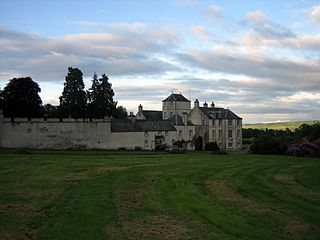
Foulis Castle is situated two miles south-west of Evanton in the parish of Kiltearn, Ross and Cromarty, Scotland. It is a white washed mansion that incorporates an old tower house with gun loops. The castle was held by the Clan Munro from the twelfth century or earlier and they had a stronghold there.
Hector Munro or Monro may refer to:
Robert Munro may refer to:
Sir Robert Munro, 5th Baronet of Foulis was also 23rd Baron and 26th chief of the Clan Munro. He became blind and was known as the Blind Baron.

Kiltearn is a parish in Ross and Cromarty, Scotland. It is in the Presbytery of Ross.
Sir Robert Munro, 3rd Baronet of Foulis, 21st Baron and 24th chief of the Clan Munro was a 17th-century Scottish soldier and politician.
There have been three baronetcies created for persons with the surname Foulis, one in the Baronetage of England and two in the Baronetage of Nova Scotia.

The chiefs of the Scottish highland Clan Munro, the Munros of Foulis, are according to tradition, descended from a Donald Munro of Foulis who died in 1039. However, their descent can only be proved by contemporary evidence back to a Robert de Munro who died in 1369.
Sir Hector Munro, 2nd Baronet of Foulis was a Scottish noble and clan chief of the highland Clan Munro. He is also by tradition the 20th Baron and 23rd overall chief of the clan. However, he is actually the 13th chief of the Clan Munro who can be proved by contemporary evidence.
Sir Hector Munro, 1st Baronet of Foulis was a Scottish soldier, noble and clan chief of the highland Clan Munro. He is also by tradition the 19th Baron and 22nd overall chief of the clan. He is however the 12th chief of the Clan Munro who can be proved by contemporary evidence.

The Munros of Obsdale were a Scottish family and a cadet branch of the Clan Munro, a Highland Scottish clan. Their base was at Obsdale House, situated just north of the town of Alness in the Scottish Highlands. Some of the members of the Munro of Obsdale family were amongst the most distinguished Scottish military officers of the 17th century.

Clan Munro is a Highland Scottish clan. Historically the clan was based in Easter Ross in the Scottish Highlands. Traditional origins of the clan give its founder as Donald Munro who came from the north of Ireland and settled in Scotland in the eleventh century, though its true founder may have lived much later. It is also a strong tradition that the Munro chiefs supported Robert the Bruce during the Wars of Scottish Independence. The first proven clan chief on record however is Robert de Munro who died in 1369; his father is mentioned but not named in a number of charters. The clan chiefs originally held land principally at Findon on the Black Isle but exchanged it in 1350 for Estirfowlys. Robert's son Hugh who died in 1425 was the first of the family to be styled "of Foulis", despite which clan genealogies describe him as 9th baron.

The Skirmish of Alness was a conflict that took place in October 1715 in Alness, in the county of Ross in the Scottish Highlands. It was part of the Jacobite rising of 1715 and pitted Highlanders loyal to the British-Hanoverian Government of George I of Great Britain against Highlanders loyal to the Jacobite House of Stuart.
William Foulis may refer to:
Before the Acts of Union 1707, the barons of the shire of Ross elected commissioners to represent them in the unicameral Parliament of Scotland and in the Convention of the Estates.
Before the Acts of Union 1707, the barons of the shire of Inverness elected commissioners to represent them in the unicameral Parliament of Scotland and in the Convention of the Estates.
The Munros of Culrain were a minor noble Scottish family and a cadet branch of the ancient Clan Munro, a Scottish clan of the Scottish Highlands. They were seated at Culrain which is in the south of the county of Sutherland, but to the north of the main Munro clan lands in Kiltearn, Easter Ross.

Sir Hugh Munro, 8th Baronet, born 25 October 1763, was a Scottish noble and also the chief of the Clan Munro, a Scottish clan of the Scottish Highlands. By tradition he was also the twenty-sixth Baron of Foulis. Before he died a dispute took place over the legitimacy of his daughter, resulting in a lawsuit.

The Munro baronetcy, of Foulis in the County of Ross, was created in the Baronetage of Nova Scotia on 7 June 1634 for Colonel Hector Monro, with remainder to his heirs male whatsoever. On the death of his son, the 2nd Baronet, in 1651, the male line of the first Baronet failed and the title was inherited by Robert Munro, grandson of George Munro, uncle of the 1st Baronet.

The Munro baronetcy, of Lindertis in the County of Forfar, was created in the Baronetage of the United Kingdom on 6 August 1825 for the soldier and colonial administrator Thomas Munro. He was a major general in the Army and served as Governor of Madras between 1820 and 1827.